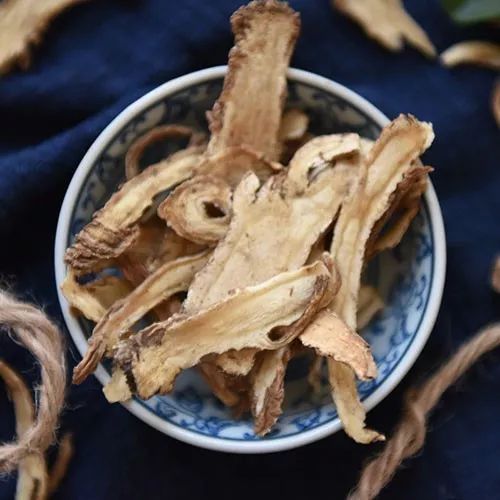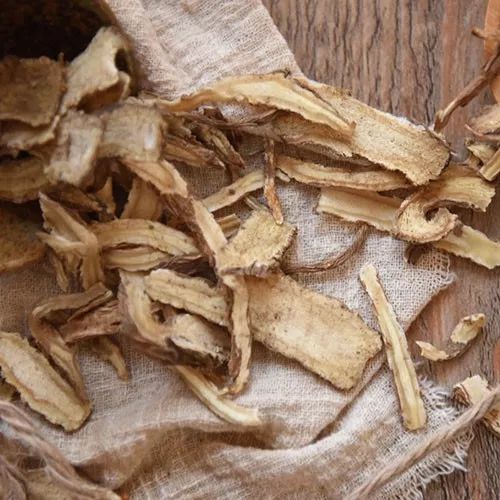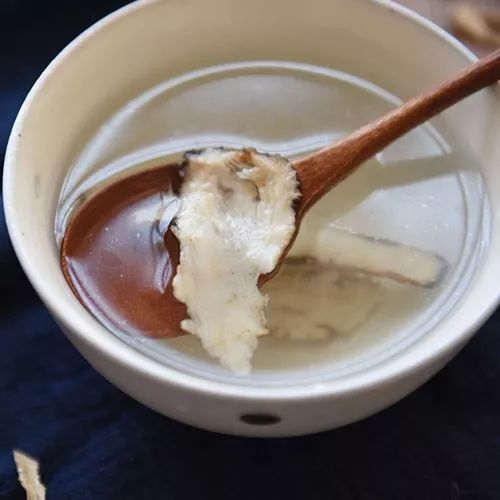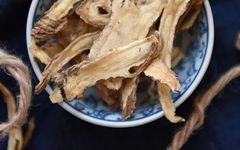Angelica sinensis (Dang Gui) has a sweet, slightly bitter taste with a mild numbing sensation. The best quality is characterized by a long main root, few lateral roots, an oily texture, a yellowish-white cross-section, and a strong aroma. Angelica sinensis is generally divided into Dang Gui Shen (including Dang Gui Tou) and Dang Gui Wei, with the whole root being commonly used.

Angelica sinensis enters the liver, heart, spleen, and large intestine meridians. Through long-term clinical observation, TCM has long established its primary functions of nourishing blood, invigorating blood circulation, regulating menstruation, and alleviating pain. As stated in the Qing Dynasty’s “Bencao Jing Baizhong Lu”: “Angelica sinensis is a must-use herb for blood disorders… it is indeed a key product for nourishing blood.” When used separately, Dang Gui Shen is better for nourishing blood and moistening the intestines, while Dang Gui Wei is more effective for invigorating blood and alleviating pain.
Modern research has provided new insights into Angelica sinensis. It contains volatile oils, organic acids, amino acids, vitamins, trace elements, and other substances that can significantly promote hematopoietic function, increase red blood cells, white blood cells, and hemoglobin levels; inhibit platelet aggregation, prevent thrombosis, and regulate blood lipids; protect against myocardial ischemia and arrhythmia, dilate blood vessels, and lower blood pressure; and regulate uterine smooth muscle. It can also enhance immunity, reduce inflammation, protect the liver, resist radiation, and act as an antioxidant to eliminate free radicals.

Benefit One: Nourishing Blood
Angelica sinensis has a sweet and heavy flavor, making it the premier herb for nourishing blood. It is suitable for symptoms caused by heart and liver blood deficiency, such as pale or sallow complexion, fatigue, pale lips and nails, dizziness, palpitations, and insomnia. When combined with Shu Di Huang (Rehmannia), Bai Shao (White Peony), and Chuan Xiong (Szechuan Lovage), it forms the representative blood-nourishing formula—”Si Wu Tang” (Four Substance Decoction), which has the effect of regulating menstruation and nourishing blood, especially suitable for treating postpartum blood deficiency.


Benefit Two: Moistening the Intestines and Promoting Bowel Movements
In TCM, it is believed that essence and blood share the same source; thus, those with blood deficiency also lack bodily fluids, leading to constipation due to insufficient intestinal fluid. Angelica sinensis can moisten the intestines and promote bowel movements, often used in combination with Ma Ren (Hemp Seed), Ku Xing Ren (Bitter Apricot Kernel), and Da Huang (Rhubarb) to treat blood deficiency constipation; or with Fang Feng (Siler), Chuan Xiong, Bai Shao, Da Huang, Bo He (Mint), and Ma Huang (Ephedra) to form Fang Feng Tong Sheng San, which can purge heat and promote bowel movements.

Benefit Three: Regulating Menstruation and Invigorating Blood
Angelica sinensis has a light and spicy nature, thus it can also invigorate blood. It can regulate menstruation and alleviate pain, especially suitable for women, particularly for conditions such as irregular menstruation, dysmenorrhea, and amenorrhea due to blood deficiency, often referred to as the “sacred medicine for women”. When combined with Tao Ren (Peach Kernel), Hong Hua (Safflower), Shu Di Huang, Bai Shao, and Chuan Xiong, it forms the famous gynecological formula—Tao Hong Si Wu Tang, commonly used for early menstruation and dysmenorrhea.

Benefit Four: Prevention and Treatment of Frostbite
In TCM, although frostbite manifests on the skin, it is often due to insufficient yang energy in the body, with external cold invading, causing stagnation of blood and qi. Therefore, treatment often involves warming the meridians, dispersing cold, invigorating blood circulation, and reducing swelling and pain. The Dang Gui Sheng Jiang Yang Rou Tang (Angelica Sinensis, Ginger, and Lamb Soup) is derived from the “Shang Han Za Bing Lun”. In this formula, Angelica sinensis nourishes and invigorates blood, ginger warms yang and disperses cold, and lamb nourishes deficiency and generates blood, collectively achieving the effects of nourishing and invigorating blood, warming yang, and dispersing cold.
Angelica sinensis is a food that is very beneficial to health and can serve many purposes. As an ingredient, it is also an excellent choice! Today, I will recommend five dietary recipes using Angelica sinensis, allowing everyone to enjoy delicious food while also gaining the health benefits of Angelica sinensis!

1. Angelica Sinensis Braised Lamb
Angelica sinensis, Gan Di Huang (Rehmannia), each 15g; Gan Jiang (Dried Ginger) 10g; Lamb 250g. Clean and cut the lamb into pieces, stir-fry in oil until white, add the herbs, water, salt, and wine, and simmer on low heat until the lamb is tender. Drink the soup and eat the meat.
Originating from “Qian Jin Yao Fang”. This formula uses lamb, Angelica sinensis, and Di Huang to nourish deficiency and benefit blood, with Gan Jiang warming the middle and strengthening the stomach. It is used for blood deficiency and weakness, or for cold abdominal pain.
2. Angelica Sinensis Lamb Soup
Angelica sinensis, Dang Shen (Codonopsis), each 15g; Huang Qi (Astragalus) 30g; Gan Jiang 10g; Lamb 500g. Slice the lamb, wrap each herb in gauze, and boil together until the meat is tender. Drink the soup and eat the meat.
Originating from “Ji Sheng Fang”. This formula uses Ren Shen (Ginseng) and Huang Qi to tonify qi, lamb to nourish blood, Angelica sinensis to nourish and invigorate blood and alleviate pain, and Gan Jiang to warm the middle and strengthen the stomach. It is used for postpartum qi and blood deficiency, fever with spontaneous sweating, and body aches.
3. Angelica Sinensis Blood Nourishing Soup
Angelica sinensis 10g, Huang Qi 60g. Boil in water to drink. The dosage can also be increased to make a thick paste.
Originating from “Nei Wai Shang Bian Huo Lun”. This formula emphasizes the use of Huang Qi, followed by Angelica sinensis, aimed at tonifying qi and benefiting blood. It is used for qi and blood deficiency after blood loss, or for qi deficiency and blood loss, with symptoms of fatigue, dizziness.
4. Angelica Sinensis and Cinnamon Wine
Angelica sinensis 30g, Shu Di Huang 50g, Hong Hua 15g, Rou Gui (Cinnamon) 6g, Sweet Wine 1000g. Soak the herbs in sweet wine for 1-2 weeks until ready.
This formula uses Angelica sinensis to nourish and invigorate blood, regulate menstruation and alleviate pain, Shu Di Huang to nourish yin blood, and Hong Hua and Rou Gui to invigorate blood and regulate menstruation, with sweet wine promoting blood circulation. It is used for blood deficiency or menstrual irregularities with stagnation.
5. Angelica Sinensis and Astragalus Honey Paste
Angelica sinensis, Huang Qi each 30g, Chen Pi (Dried Tangerine Peel) 10g, Huo Ma Ren (Hemp Seed) 100g, honey to taste. Crush the hemp seeds, combine with the three herbs, add water to extract the juice, then boil until thick, mix in equal parts of honey, and stir until dissolved. Take 1-2 spoonfuls each time.
This formula uses Huang Qi to tonify the middle and benefit qi, while Angelica sinensis, honey, and Huo Ma Ren moisten the intestines, and Chen Pi regulates qi. It is used for elderly individuals with qi deficiency and dry intestines, leading to constipation and spontaneous sweating.
 Suitable Population for Angelica Sinensis
Suitable Population for Angelica Sinensis
1. Suitable for those with irregular menstruation, dysmenorrhea, qi and blood deficiency, headaches, dizziness, and constipation.
2. Contraindicated for those with excessive heat and bleeding, those with dampness and fullness, and pregnant women should use with caution.
3. For blood deficiency or anemia, symptoms include dizziness, fatigue, pale complexion, pale tongue, and thin pulse, as well as abdominal pain and headaches due to blood deficiency, often combined with Shu Di Huang, Bai Shao, or blood-nourishing and qi-tonifying ingredients like lamb and Huang Qi.
4. For conditions of blood stasis, such as trauma, swelling and pain; wind-cold-damp obstruction, numbness and pain in limbs; shoulder periarthritis; and thrombotic occlusive vasculitis, often combined with Chuan Xiong, Chi Shao (Red Peony), and other blood-invigorating herbs.
5. For menstrual irregularities, amenorrhea, and dysmenorrhea caused by blood deficiency or stasis, often combined with Shu Di Huang, Chuan Xiong, Dan Shen (Salvia), and other blood-nourishing and invigorating herbs.
6. For abscesses and sores with insufficient qi and blood, where pus does not drain or heals slowly, often combined with Huang Qi to support righteous qi.
7. For constipation due to blood deficiency and dry intestines, often combined with Rou Cong Rong (Cistanche) and Huo Ma Ren to moisten the intestines.

